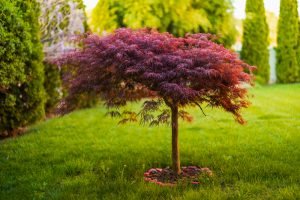Maple trees are a gorgeous option to add to almost any garden. They add the perfect splash of colour to any property during autumn and spring, while providing ample shade during the summer. They also don’t require too much attention. These beautiful, robust trees grow quickly, but you have to know hot to properly care for your maple trees to ensure they remain healthy. Today we are going to discuss our top 7 tips to grow a Healthy Maple Tree.
1: Soil
The ideal soil conditions are the most important factor when it comes to growing a healthy maple tree. Maple trees thrive in acidic soil, ranging between 5-7 on the pH scale. If you’re unsure if your soil is suitable for a maple tree, we recommend purchasing a soil testing kit or a pH resting probe.
Depending on your test results, you can add limestone to increase alkalinity or soil sulphur to increase acidity. Organic compost can also help maintain the soil’s acid levels.
Once you’re sure the soil is suitable, you can begin digging the hole for your tree. The hole should be about 3 feet deep. You should keep in mind that the maple tree’s roots should have approximately 4 feet of space to spread. Therefore, try to avoid planting your tree near fences and other potential obstacles.
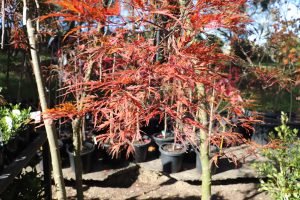
2: Watering
Watering your maple tree properly is critical, especially in the first few years leading up to the tree’s maturity. Maple trees prefer most, well-drained soil, however different varieties of maple will prefer different amounts of water. It is important you research exactly how much water your type of maple will prefer.
Immediately after planting your tree, you should soak the soil around the root ball deeply. Check the soil moisture daily and water again when the soil is dried out or only lightly damp. Don’t water every single day. While you might think you’re encouraging growth, you’re actually doing more harm than good. Only water your maple when necessary.
Maple trees are usually considered established after two growing seasons, and they won’t require nearly as much water or attention after this point. However, it is crucial to still check the soil moisture during droughts and provide supplemental water when necessary.
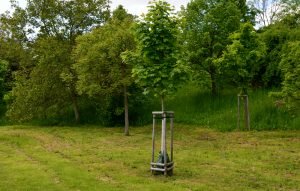
3: Fertilising
Growing maple trees benefit from fertiliser but established trees won’t require it as their root systems will get plenty of nutrients from the soil and rainfall. Younger, growing trees however will need a good fertiliser to help them establish a strong root system. You should fertilise your maple trees in early spring after they have a few new leaves. However, it’s only necessary if you think the tree look full during the previous growing season.
Maple trees do best with a slow-release fertiliser or organic plant food. You should avoid quick-release fertilisers for your maple tree where possible.
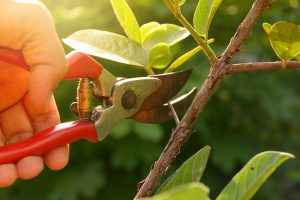
4: Pruning
Maple trees may bleed some sap when you cut them and while this might look concerning, it’s nothing to worry about. Pruning your maple tree isn’t necessary if you like the natural look and the tree will grow properly without pruning. Pruning, however, with help create a more appealing canopy that provides more shade.
The best time to prune your maple tree is in summer. Pruning in winter or spring can cause major sap bleeding, which can be more harmful to younger trees than older trees. So any significant cuts need to be made during the summer season.
Pruning your maple consists of removing dead, crossed, broken, and crowded branches. This helps ensure the tree stays in healthy shape and continues to thrive properly. However, it’s important to avoid removing any main branches as you risk destroying the natural shape and sturdy structure of the tree.
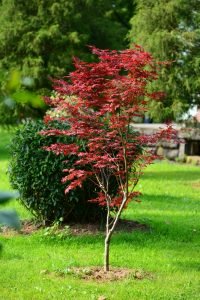
5: Diseases
Maple trees can, unfortunately, fall prey to a variety of diseases. But the ones gardeners are generally most concerned about are those that affect the trunk and the bark. These is because these diseases a very visible to a tree’s owner and can often bring about dramatic changes to the tree. We have listed a few common diseases below:
Canker Fungus
This is the most common type of maple bark disease. Canker fungi all have the same thing in common, which is that they will create lesions – cankers – in the bark but these lesions look different depending on the type of fungus that is affecting the maple bark.
Nectria Cinnabarina Canker
This canker can be identified by its pink and black cankers on the bark and typically affects parts of the trunk that are weak or dead. Nectria cinnabarina cankers usually become slimy after rain or due. This fungus typically appears as red balls on the bark of the maple tree.
Nectria Galligena Canker
This type of canker will attack a maple tree while it’s dormant and will kill healthy bark. In the spring, the maple will regrow slightly thicker layer of bark over the fungus infected are and then, the following dormant season, the fungus will kill the bark again. Over time the tree will develop a canker that looks like a stack of paper that has been split then peeled back.
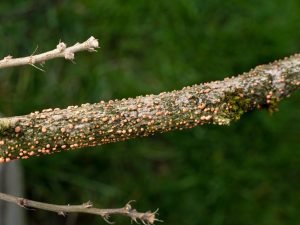
Eutypella Canker
These maple tree cankers look similar to nectria galligena but the layers on the canker will normally be thicker and will not peel away from the tree trunk easily. Also, if the bark is removed from the canker there will be a layer of visible, light brown mushroom tissue.
Valsa Canker
The valsa canker will normally only affect young trees or small branches. The fungus will look like small shallow depressions on the bark with warts in the centre of each and will be white or grey.
Steganosporium Canker
This disease is characterised by a brittle, black layer over the bark of the tree. It only affects bark that has been damaged by other issues or other maple diseases.
Cryptosporiopsis Canker
The cankers caused by this fungus will affect young trees. It starts out as a small, elongated canker that looks as though someone pushed some of the bark into the tree. As the tree grows, the canker will continue to grow. The centre of the canker will often bleed during the rising of the spring sap.
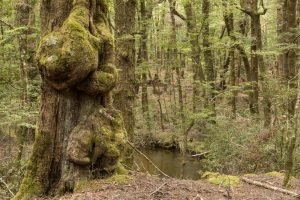
Bleeding Canker
This type of canker causes the bark to appear wet and is often accompanied by some bark coming away from the maple tree trunk. This is especially evident lower down on the trunk of the tree.
Basal Canker
These cankers attack the base of the tree and rot away the bark and wood beneath. Basal cankers look very similar to a maple tree root disease called collar rot however basal cankers will cause the bark to fall away from the base of the tree.
Galls and Burls
It isn’t uncommon for maple trees to develop growths known as galls or burls. These growths look like large warts on the side of the maple tree and can get to massive sizes. They are often alarming to see, however galls and burls will not harm a tree. The growths do weaken the trunk of the maple tree, though, and can make the tree more susceptible to falling during windstorms.
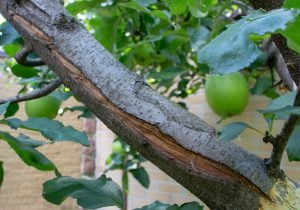
6: Environmental Damage to Maple Trees
As well as disease, maple trees can suffer from a variety of environmental damage. Below are the two of the most common types of environmental damage.
Sunscald
This type of environmental damage occurs most frequently on young maple tress but can happen on older maple trees that have thin skin. It will appear as a long, discoloured or even bark-less stretches on the trunk of the maple tree. Sometimes the bark will even be cracked. The damage will be on the southern side of the tree.
Frost Cracks
Like sunscald, this environmental damage occurs on the southern side of the tree. Sometimes deep cracks will appear in the trunk. These frost cracks will most commonly appear in later winter or spring. This can occur due to over mulching your maple tree. Poor mulching practices can cause the bark around the base of the tree to crack and fall off.
7: Maple Tree Dying
All plants can decline for a variety of different reasons and maples are no different. Urban trees need special care to prevent stress factors that cause decline. There are a variety of adverse conditions that can cause a maple tree so much stress that it can no longer thrive. Maple trees growing in backyards can become victims of air and water pollution, be defoliated by insects, and put on a new flush of leaves that use up too much energy.
Without energy reserves, trees become vulnerable to decline. When a maple tree depletes its energy reserves fighting off environmental stress and physical injuries, it leaves the tree open to secondary infections. Other causes of maple decline include root breakage and soil compaction from heavy equipment, nutritional imbalance, prolonged drought, and vandalism. Anything that causes your maple to expend energy to recover can weaken your tree and, if it happen repeatedly, the tree will go into decline.
Below are a list of symptoms that signify a maple tree declining:
- Failure to put on adequate new growth
- Twigs not adding on new growth each year
- Paler, smaller leaves
- Dead twigs, dead branch tips, and dead areas in the canopy
- Leaves that change to autumn colours before the end of summer
Early intervention can help prevent a declining maple tree from dying completely. Try to identify the cause as soon as possible and correct the problem.
Aumanns currently has a gorgeous collection of maple trees for sale. Come into our Templestowe store today and let us help you find the perfect maple tree for your home and garden.


